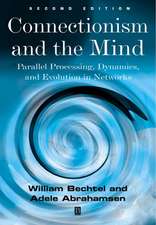Proceedings of ELM-2016: Proceedings in Adaptation, Learning and Optimization, cartea 9
Editat de Jiuwen Cao, Erik Cambria, Amaury Lendasse, Yoan Miche, Chi Man Vongen Limba Engleză Hardback – 26 mai 2017
This book covers theories, algorithms ad applications of ELM. It gives readers a glance of the most recent advances of ELM.
| Toate formatele și edițiile | Preț | Express |
|---|---|---|
| Paperback (1) | 987.17 lei 6-8 săpt. | |
| Springer International Publishing – 9 mai 2018 | 987.17 lei 6-8 săpt. | |
| Hardback (1) | 993.42 lei 6-8 săpt. | |
| Springer International Publishing – 26 mai 2017 | 993.42 lei 6-8 săpt. |
Din seria Proceedings in Adaptation, Learning and Optimization
- 20%
 Preț: 1299.64 lei
Preț: 1299.64 lei - 20%
 Preț: 1280.69 lei
Preț: 1280.69 lei - 20%
 Preț: 1274.57 lei
Preț: 1274.57 lei - 20%
 Preț: 1271.78 lei
Preț: 1271.78 lei - 20%
 Preț: 1912.11 lei
Preț: 1912.11 lei - 20%
 Preț: 1272.61 lei
Preț: 1272.61 lei - 20%
 Preț: 1457.06 lei
Preț: 1457.06 lei - 20%
 Preț: 1436.76 lei
Preț: 1436.76 lei - 20%
 Preț: 1750.92 lei
Preț: 1750.92 lei - 20%
 Preț: 1298.33 lei
Preț: 1298.33 lei - 20%
 Preț: 1285.97 lei
Preț: 1285.97 lei - 20%
 Preț: 1283.64 lei
Preț: 1283.64 lei - 20%
 Preț: 1285.45 lei
Preț: 1285.45 lei - 20%
 Preț: 1290.40 lei
Preț: 1290.40 lei - 20%
 Preț: 1289.59 lei
Preț: 1289.59 lei
Preț: 993.42 lei
Preț vechi: 1241.77 lei
-20% Nou
Puncte Express: 1490
Preț estimativ în valută:
190.09€ • 198.47$ • 157.32£
190.09€ • 198.47$ • 157.32£
Carte tipărită la comandă
Livrare economică 05-19 aprilie
Preluare comenzi: 021 569.72.76
Specificații
ISBN-13: 9783319574202
ISBN-10: 3319574205
Pagini: 285
Ilustrații: XIII, 285 p. 143 illus., 126 illus. in color.
Dimensiuni: 155 x 235 x 18 mm
Greutate: 0.59 kg
Ediția:1st ed. 2018
Editura: Springer International Publishing
Colecția Springer
Seria Proceedings in Adaptation, Learning and Optimization
Locul publicării:Cham, Switzerland
ISBN-10: 3319574205
Pagini: 285
Ilustrații: XIII, 285 p. 143 illus., 126 illus. in color.
Dimensiuni: 155 x 235 x 18 mm
Greutate: 0.59 kg
Ediția:1st ed. 2018
Editura: Springer International Publishing
Colecția Springer
Seria Proceedings in Adaptation, Learning and Optimization
Locul publicării:Cham, Switzerland
Cuprins
From the Content: Earthen Archaeological Site Monitoring Data Analysis Using Kernel-based ELM and Non-uniform Sampling TFR.- A Multi-Valued Neuron ELM with Complex-Valued Inputs for System Identification using FRA.- Quaternion Extreme Learning Machine.
Textul de pe ultima copertă
This book contains some selected papers from the International Conference on Extreme Learning Machine 2016, which was held in Singapore, December13-15, 2016. This conference will provide a forum for academics, researchers and engineers to share and exchange R&D experience on both theoretical studies and practical applications of the ELM technique and brain learning. Extreme Learning Machines (ELM) aims to break the barriers between the conventional artificial learning techniques and biological learning mechanism. ELM represents a suite of (machine or possibly biological) learning techniques in which hidden neurons need not be tuned. ELM learning theories show that very effective learning algorithms can be derived based on randomly generated hidden neurons (with almost any nonlinear piecewise activation functions), independent of training data and application environments. Increasingly, evidence from neurosciencesuggests that similar principles apply in biological learning systems. ELM theories and algorithms argue that “random hidden neurons” capture an essential aspect of biological learning mechanisms as well as the intuitive sense that the efficiency of biological learning need not rely on computing power of neurons. ELM theories thus hint at possible reasons why the brain is more intelligent and effective than current computers. ELM offers significant advantages over conventional neural network learning algorithms such as fast learning speed, ease of implementation, and minimal need for human intervention. ELM also shows potential as a viable alternative technique for large‐scale computing and artificial intelligence.
This book covers theories, algorithms ad applications of ELM. It gives readers a glance of the most recent advances of ELM.
This book covers theories, algorithms ad applications of ELM. It gives readers a glance of the most recent advances of ELM.
Caracteristici
Recent research on Extreme Learning Machine Selected papers from the International Conference on Extreme Learning Machine 2016, which was held in Singapore, December 13-15, 2016 Presents Theory, Algorithms and Applications

















